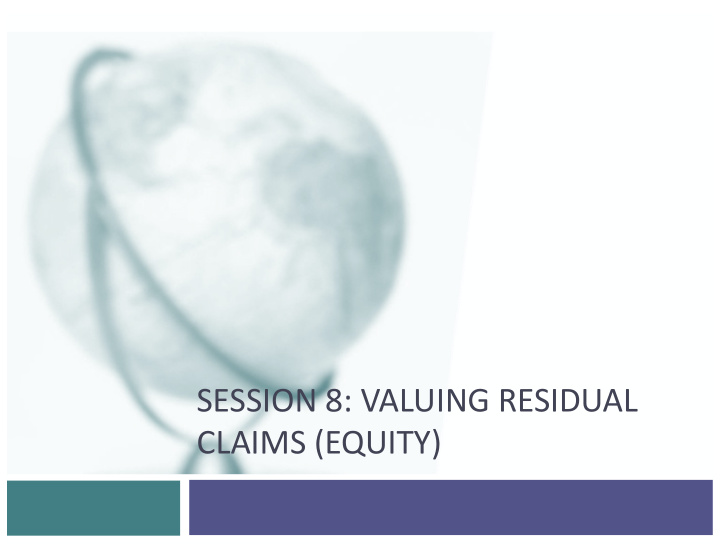



SESSION 8: VALUING RESIDUAL CLAIMS (EQUITY)
Valuing Equity ¨ Equity represents a residual cashflow rather than a promised cashflow. ¨ You can value equity in one of two ways: ¤ By discounting cashflows to equity at the cost of equity to arrive at the value of equity directly. ¤ By discounting cashflows to the firm at the cost of capital to arrive at the value of the business. Subtracting out the firm’s outstanding debt should yield the value of equity. 2
Equity Valuation 3
Equity Cash Flows ¨ Dividends: Strictly speaking, the only cash flow that equity investors in a publicly traded firm get from the firm is dividends. The earliest valuation models were built around dividends. ¨ Free Cash Flow to Equity: This is a measure of potential dividends. We consider a broader definition of cash flow to which we call free cash flow to equity , defined as the cash left over after operating expenses, interest expenses, net debt payments and reinvestment needs. By net debt payments , we are referring to the difference between new debt issued and repayments of old debt. If the new debt issued exceeds debt repayments, the free cash flow to equity will be higher. 4
The Cost of Equity ¨ The cost of equity is the rate of return that equity investors demand for being invested in the stock. It should reflect the risk that they see in the stock, with higher risk going with higher costs of equity. ¨ It can be different for different investors in the same business, but when valuing that business, you should use the cost of equity of the marginal investors in the stock. 5
A Simple Example: A stable growth dividend paying stock ¨ Consolidated Edison, the utility that produces power for much of New York city, paid dividends per share of $ 4.00 in 2016, roughly 70% of its earnings per share in that year. ¨ It is a mature firm that expects to grow 2% a year in perpetuity (with dividends following suit) ¨ The cost of equity for the firm is 8%. ¨ The value per share can be estimated as follows: Value of Equity per share = $4.00 (1.02) / (.08 - .02) = $ 68.00 ¨ The stock was trading at $ 70 per share at the time of this valuation. We could argue that based upon this valuation, the stock is slightly over valued. 6
A FCFE Aside ¨ When you are using dividends to value Con Ed, you are implicitly assuming that it is paying out what it can afford. ¨ Assume that you are able to compute the cash flows left over after reinvestment needs and debt payments and it is $4.25/share for the most recent 12 months. Value of Con Ed = $4.25 (1.02)/(.08-.02) = $72.25 7
Firm Valuation 8
Cash Flow to the Firm ¨ Cash flow to Firm : There is also a broader definition of cash flow that we can use, where we look at not just the equity investors in the asset, but at the total cash flows generated by the asset for both the equity investor and the lender. ¨ This cash flow, which is before debt payments but after operating expenses and taxes, is called the cash flow to the firm . 9
The Cost of Capital ¨ The cost of capital is a composite cost of all of the capital invested in an asset or business. It brings in the cost and weight of debt. ¤ The cost of debt is the rate at which a business can borrow money, long term, today. ¤ The cost of capital will be a weighted average of the cost of equity and the after-tax cost of borrowing. Cost of Capital = Cost of Equity (Equity/ (Debt + Equity) + Cost of Debt (1- tax rate) (Debt/(Debt+ Equity) 10
The four determinants of the value of a business… 11
Valuation Consistency ¨ If you make consistent assumptions about cash flows, debt ratios and risk, you should get the same value for equity, whether you value equity directly (by discounting cash flows to equity at the cost of equity) or indirectly (by discounting cash flows to the firm at the cost of capital). ¨ It is really difficult to stay consistent as you move from one approach to the other. 12
Recommend
More recommend